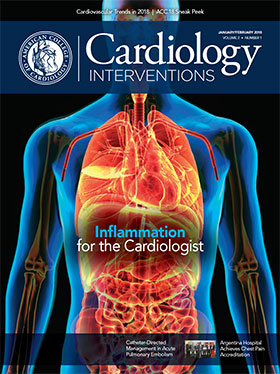Quality Improvement | What a Difference a Year Makes: Argentina Hospital Achieves Chest Pain Accreditation
When Javier A. Sala Mercado, MD, PhD, learned about ACC’s Chest Pain Center Accreditation, in spring 2016, he began a mission to make his center a model for cardiovascular care in Argentina. The path to accreditation, Sala Mercado reasoned, could help achieve that goal by streamlining and standardizing treatment practices for patients with suspected acute coronary syndrome (ACS) across Instituto Modelo de Cardiologia Privado (IMC). Only one year later, IMC became the first hospital in South America to receive Chest Pain Center Accreditation. And Sala Mercado has expanded his vision: to be the model for accreditation for Spanish-speaking hospitals in South America.
“Prior to accreditation, we believed we were treating ACS patients the best we could, our processes were up to date, our time assignments for each step were accurate, and our communication with the patient and the family was optimal,” says Sala Mercado, vice chief operating officer at IMC in Cordoba, Argentina. “But there were actually many opportunities for improvement.”
The first challenge for Sala Mercado was to assemble IMC’s Chest Pain Center Committee – a group of 11 IMC physicians, plus one biochemist and one quality and process administrator, who would oversee the accreditation process. The team included a board member, as well as physicians from the emergency department (ED), intensive care unit, post-operative unit, central laboratory and catheterization laboratory, among others. Involving staff from across the hospital was critical to the project’s success.
“Having a team that includes physicians and non-physicians from different levels across the hospital ensures buy in from department leaders and encourages each department to evaluate and adjust their processes to improve care,” says Phillip D. Levy, MD, MPH, FACC, chair of the ACC Accreditation Management Board. “It ensures everyone is aligned in achieving the same goal.”
With the committee assembled, the process began in earnest in August 2016 with a site visit by staff from ACC Accreditation Services to review accreditation requirements and conduct a gap analysis. This analysis gathers baseline metrics on the hospital’s performance in relation to relevant ACC/AHA guidelines. For IMC, the gap analysis revealed that the hospital had not been collecting certain data points – including door-to-electrocardiography (ECG), door-to-troponin (TnT) and point-of-entry times, all of which were required for ACC accreditation.
"Having a team that includes physicians and non-physicians from different levels across the hospital ensures buy in from department leaders and encourages each department to evaluate and adjust their processes to improve care." — Phillip D. Levy, MD, MPH, FACC
Immediately the committee created a data collection protocol and data acquisition form for all required data to be uploaded to the database. By collecting this data in a streamlined and organized way, guided by the protocol, IMC learned that only 17 percent of their STEMI and NSTEMI patients arrived via emergency medical services (EMS). Sala Mercado and his team had thought most of these patients arrived through EMS. About one-third of patients were transferred to IMC from hospitals without PCI, 40 percent presented in the ED and 5 percent had been admitted directly. Another 5 percent were already in the hospital when the acute myocardial infarction began.
“This is by far one of the most important things we discovered as we went through the accreditation process,” Sala Mercado says. “Previously, we didn’t have the faintest idea how much time elapsed from the patient’s first contact with IMC staff or EMS to the diagnosis or the ECG or TnT results.” By starting the clock at the patient’s first contact, the committee identified areas where they could refine the protocol to reach a diagnosis and develop a treatment strategy as quickly as possible.
Chest Pain Accreditation in a Nutshell

Chest Pain Center v6 Accreditation is a quality improvement program designed for hospital cardiovascular teams focused on the efficient and effective care of acute coronary syndrome patients. A Chest Pain Center (CPC) Accreditation program offers a unique opportunity to examine and assess operational fitness without intimidating scrutiny or daunting penalties for noncompliance.
Using the accreditation tool as a roadmap for sustainable performance improvement, a hospital can establish consistent, high-quality processes across the continuum of care. NCDR’s ACTION Registry is compatible with CPC v6 for collection of acute myocardial infarction patient data to further inform and enhance clinical decision-making.
CPC v6 Accreditation helps you:
- Reduce variation in care
- Lower length of stay
- Sustain consistent process improvement
- Decrease readmissions
- Maximize reimbursements
“In the event of a heart emergency, time literally translates to muscle,” Levy says. “Hospitals need to constantly look at their data, find areas for improvement and develop innovative ways to improve processes. The key to preserving muscle is making a diagnosis and developing a treatment plan as quickly as possible.”
The ACC/AHA guideline standard of a door-to-TnT of 90 minutes or less was met for only 59 percent of patients with suspected ACS in October 2016 when IMC began collecting the data. In less than a year, thanks to new processes the team put in place, 94 percent of patients were within the guideline. These processes included standardizing criteria and procedures for ordering the TnT test and a dedicated single centrifuge in the lab for TnT tests. With these protocols in place, the turnaround time for the lab to provide TnT results decreased by 22 minutes.
The committee also optimized the process to administer an ECG and interpret results. According to baseline data, only 42 percent of patients fell within the ACC/AHA guideline criterion of having ECG results read by a physician within 10 minutes of hospital arrival. A year later, the hospital met the guideline for 92 percent of patients.
Just nine months after the gap analysis, this intense work paid off when the IMC became the first hospital in South America and the fourth outside the U.S. to receive Chest Pain Center, Cath-PCI Accreditation, joining more than 1,000 facilities worldwide. This achievement came in May 2017 after a site visit that included a two-day evaluation by staff from ACC Accreditation Services.
But the work hasn’t stopped there for Sala Mercado and his team. “The accreditation gave us the foundation for what is to come; a baseline to continue advancing,” he says. Not only for his hospital, but others too as IMC becomes a model for cardiovascular care in South America. Next up: IMC is working to meet requirements for ACC’s Heart Failure Accreditation in 2018. If this happens, it will be the first facility outside the U.S. to receive heart failure accreditation.
Keywords: ACC Publications, Cardiology Interventions, Accreditation, Acute Coronary Syndrome, Catheterization, Chest Pain, Continuity of Patient Care, Electrocardiography, Emergency Service, Hospital, Heart Failure, Hospitals, Intensive Care Units, Length of Stay, Myocardial Infarction, Pain Clinics, Patient Readmission, Quality Improvement, Registries, Syncope, Troponin
< Back to Listings



